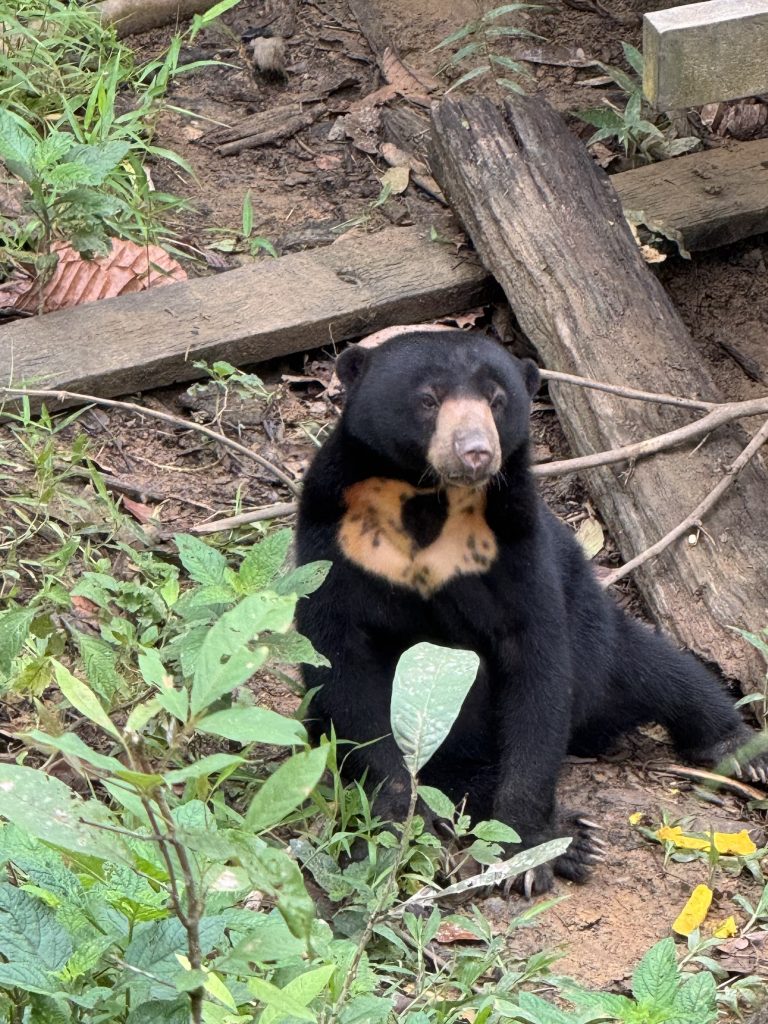
Right across the road from the orangutan sanctuary is the sun bear sanctuary. The Borneo Sun Bear is the world’s smallest bear. No one knows how many bears are left in the wild, but they’re very endangered.
Look at that sunburst on its chest!
Sun bears have the same protection under the law as the orangutan. Their gall bladders, fur and claws make them vulnerable to poachers. Honestly, aren’t people awful?
A lot of these rescued bears were sold as pets when they were babies. As soon as they grew up a bit, the families keep them in cages. Sometimes they let them out in the rainforest, but of course the bears don’t know how to forage for food, so they come into villages and the people get scared.
A keeper was throwing food to them. You can hear her explanation as to why they feed them this way.
I took a few 10 second videos, waiting for her moment of triumph. You can hear how strong her jaws are, as she rips into that log.
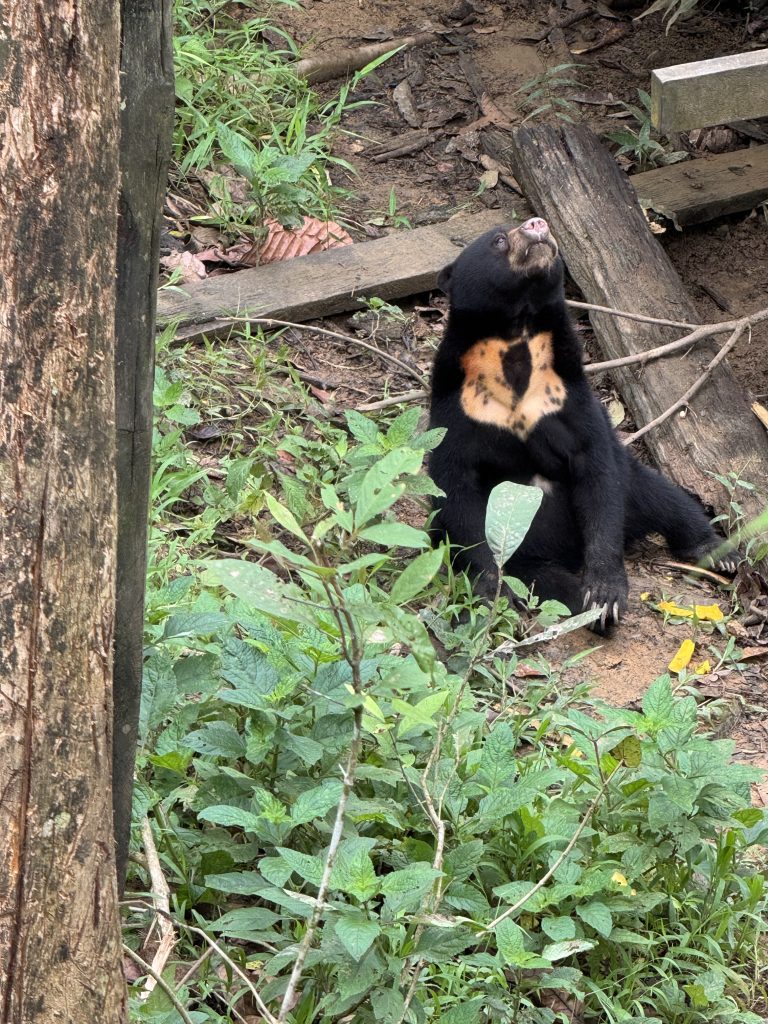
Here’s one last look at the surprising markings they have on their chests.
Are they as interesting as the orangutans? My answer would be no. But I’m glad we saw them, all the same.

After a lovely buffet lunch, we were taken to the rainforest canopy walk. This is touted as a great place for birds and other animals, even wild orangutans. This lake greets you as you walk in.
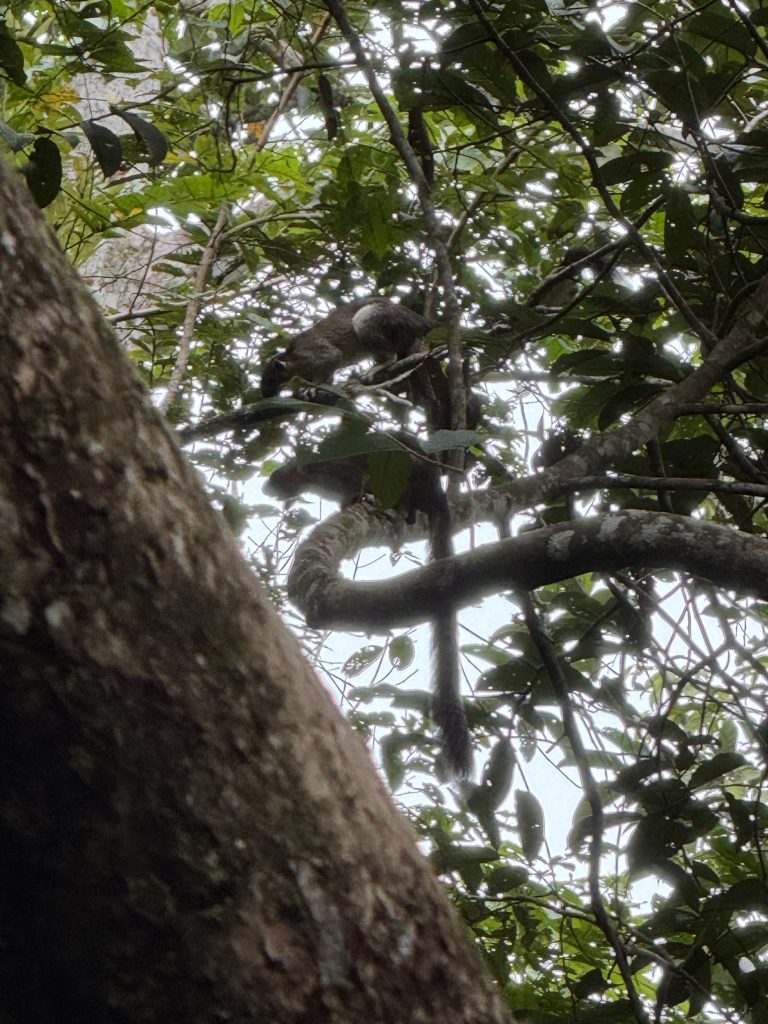
This blurry photo is of the only animals we saw during the whole thing… and we saw them not 5 minutes after we started walking along the platform. They’re large white squirrels.
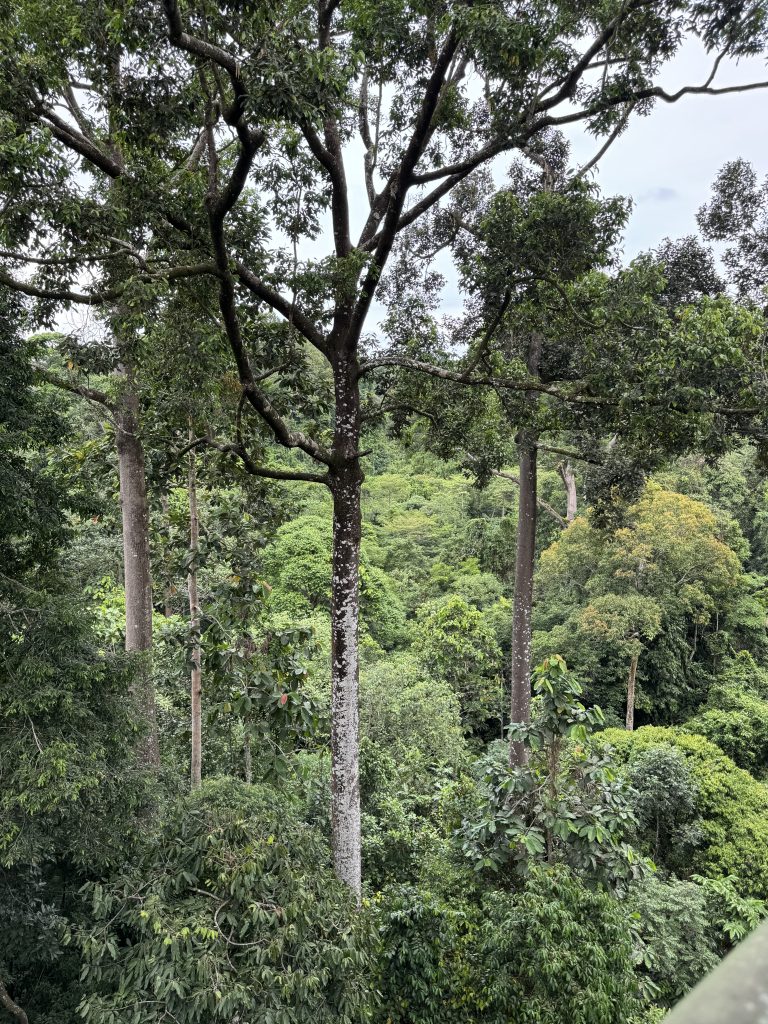
Sarah was walking at the front, looking, looking… then she looked down and sighed. “After all the rain yesterday, it’s flooded,” she said. “Animals are like us. They don’t go to an area that’s flooded.”
Remember how the last game drive in Kenya was like that after it rained?

While most of us climbed a very tall tower, Sarah scooted off to check the jungle path part of the walk. There she is!
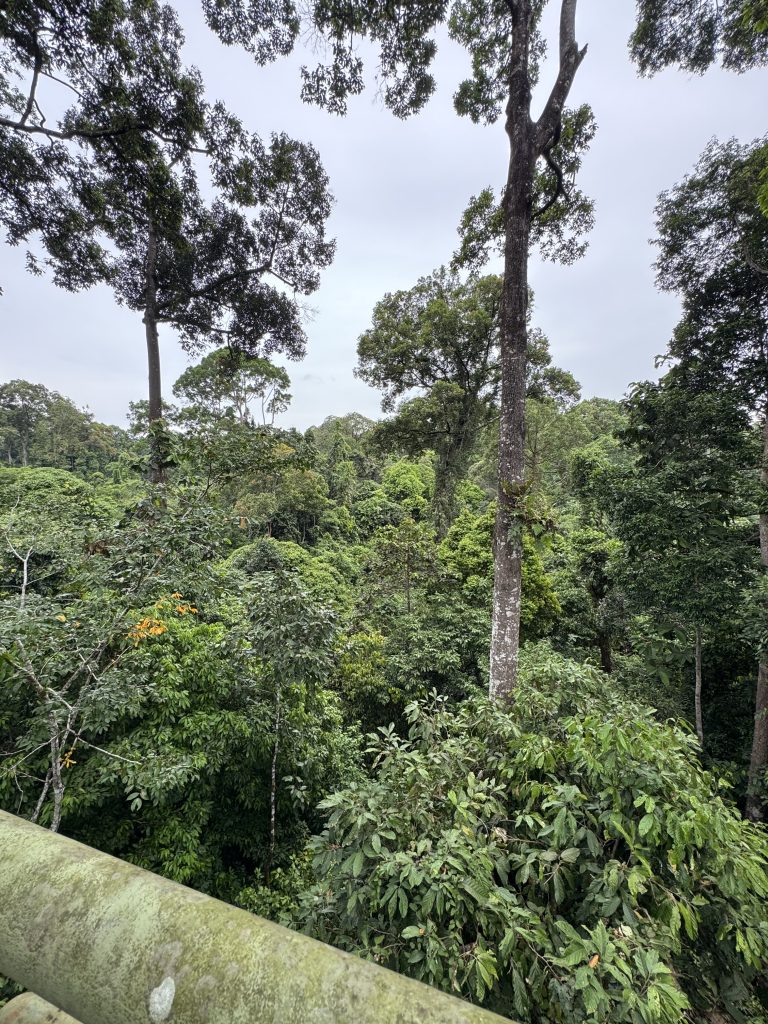
A couple of women in the group have excellent cameras, and they managed to snap photos of a rare bird. I can’t remember what it was called, but it looked beautiful in their photos.
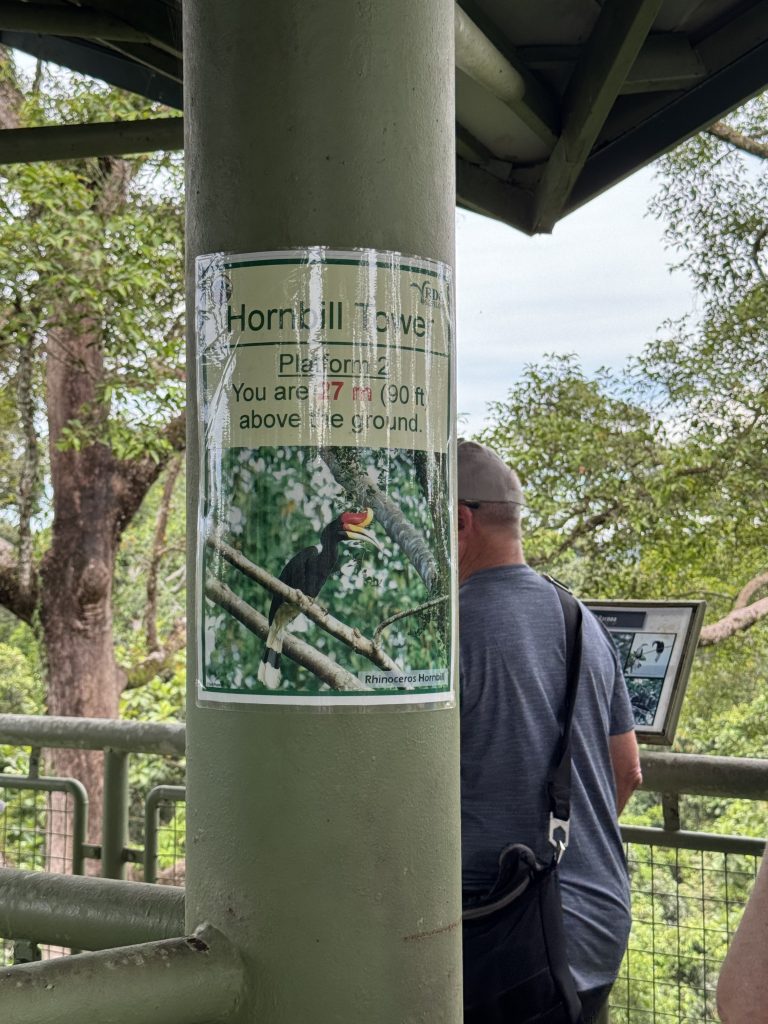
I spotted a group of black squirrels playing in a tree almost at eye level – so they were leaping around VERY high off the ground. They were moving too quickly for me to take a photo.
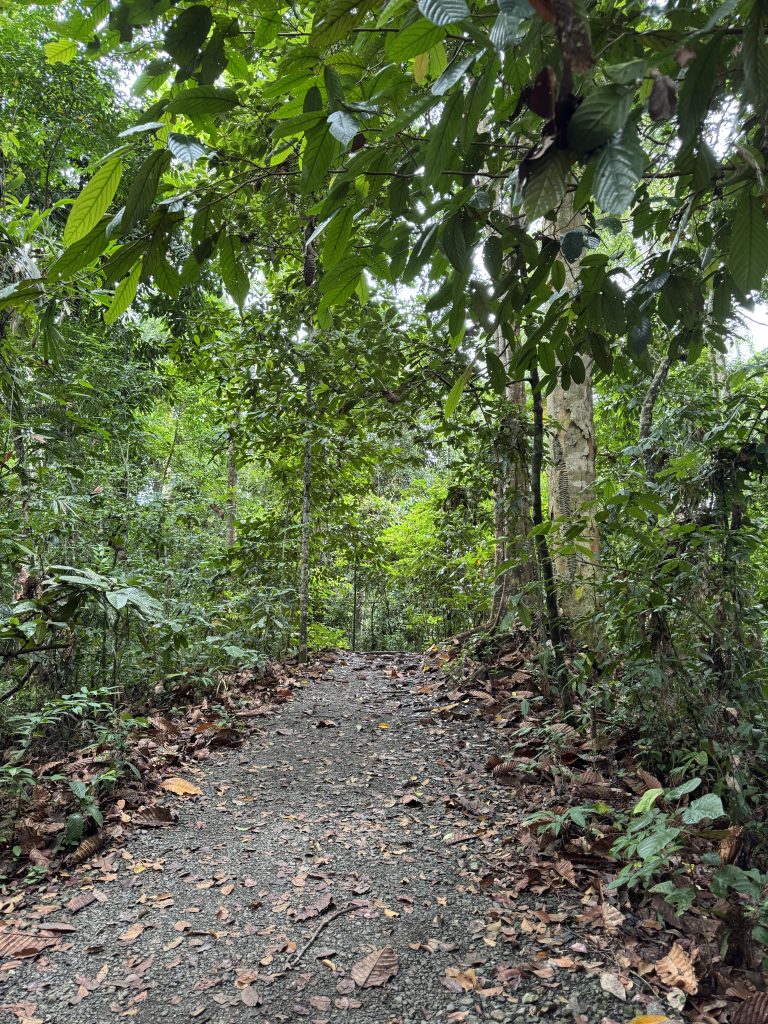
Once I realised that Sarah was right, and we weren’t going to be wading through knee-deep mud, I enjoyed this walk through the rainforest. It reminded me so much of the walk that we did in Zanzibar. Though to be fair, we saw monkeys and butterflies then.
But it was very peaceful.
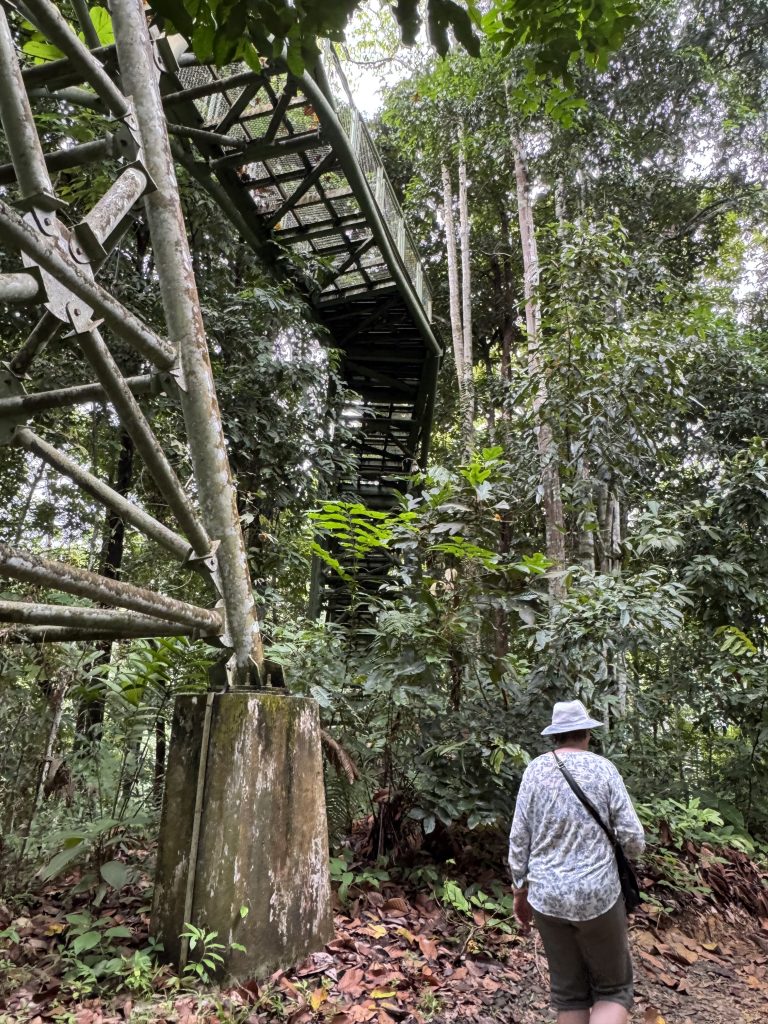
Walking underneath the platform we walked on just 20 minutes before.
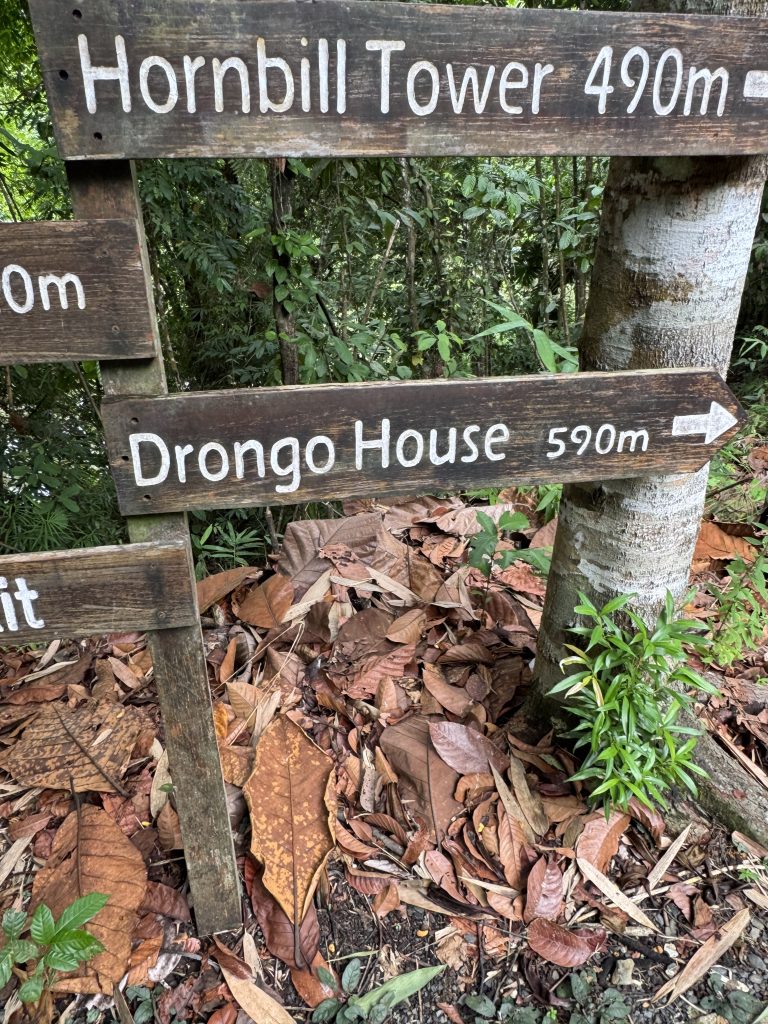
When Dad was a boy, the word “fro go” meant that you were a bit stupid. Heh heh.
It was a pleasant walk, but the last stop of the day was a place that was a bit more sobering. We were going to the Sandakan War Memorial Garden, which was built on the spot where the Australian POWs were housed during World War II.
The Japanese did some terrible things during WWII and before that in China and Korea, but they really outdid themselves with the Sandakan Death March.
”The Sandakan Death Marches were a series of forced marches in Borneo from Sandakan to Ranau which resulted in the deaths of 2,434 Allied prisoners of war held captive by the Empire of Japanduring the Pacific campaign of World War II at the Sandakan POW Camp, North Borneo.[1] By the end of the war, of all the prisoners who had been incarcerated at Sandakan and Ranau, only six Australians survived, all of whom had escaped. It is widely considered to be the single worst atrocity suffered by Australian servicemen during the Second World War.[2]” Wikipedia.
I wasn’t expecting the first thing I saw here would be a wedding party.
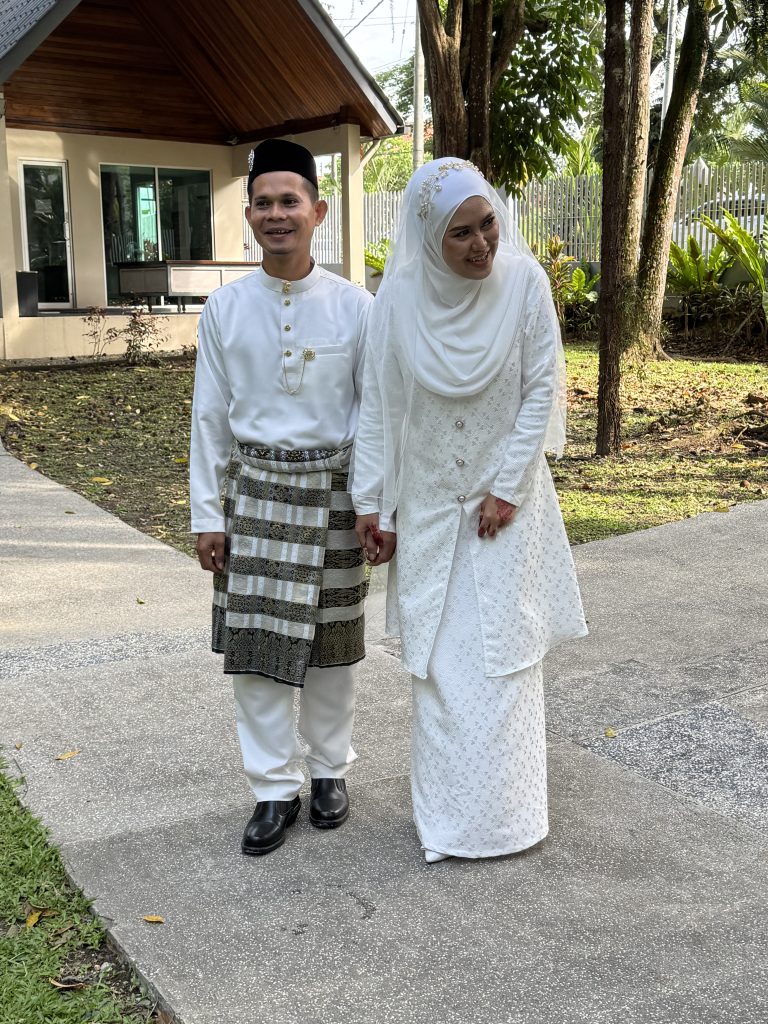
They were here with their photographer. They were taking pictures of us taking pictures of them!
I saw them later when I was at the monument. They were walking, she holding her flowers and he was looking at his phone.
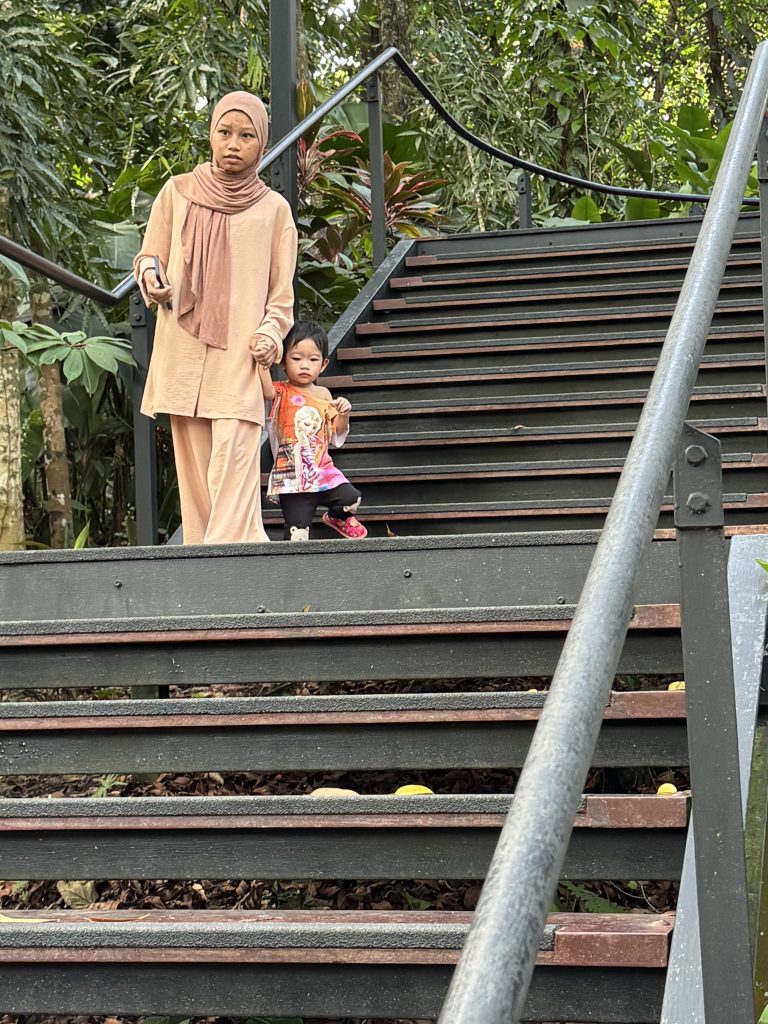
This little girl was so cute. Every time she stepped, her right shoe would let out a very loud SQUEAK, like a dog’s chew toy.
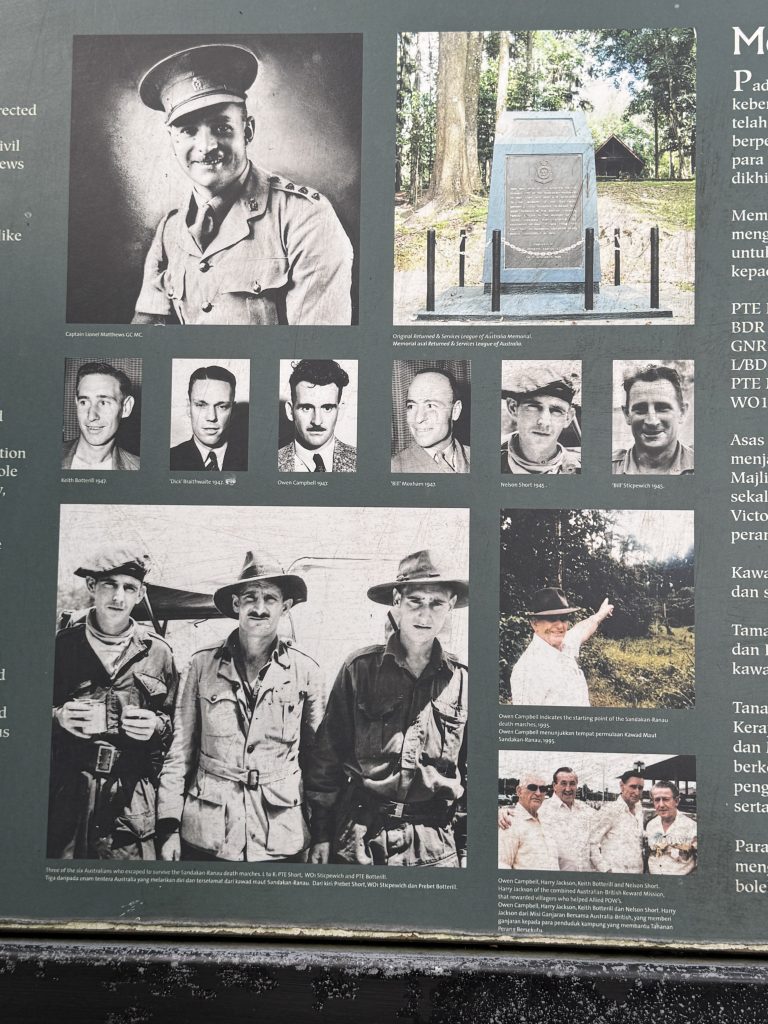
The park has a little memorial display, like the one in Hiroshima only just one room. These 6 men, all Australians, are the only ones out of 2,000+ men to survive the death marches. These only reason they did, was because they escaped and locals helped hide them and get them away.
This wasn’t a foolproof plan. There were a few stories in the exhibit of men who were turned in to the Japanese by locals.
Dick Braithewaite (second from the left) wrote a book about his experience here, called ‘Fighting Monsters.’ Sarah has read it, which is how she was able to tell us so much about it.
I’m a fast reader, so I was through the exhibit before anyone else. I was talking to Sarah about how my grandfather, George, was in the war as a mechanic on the planes in Darwin. He was ordered to go on a mission to attack a Japanese camp in New Guinea(I think.) There was hand to hand fighting and, as he was running to get back to his row boat to get to the ship/ submarine to get away, he found a friend who was badly wounded. He helped him into his boat, then started rowing as quickly and quietly as possible, while behind him, the Japanese were coming.
His friend died in the boat next to him. As he kept rowing, he heard a voice ahead of him say in English, “We may as well go. I don’t think there are any more coming.”
George’s blood froze. “Yes, there bloody well is!” he called, then began to row like hell.
Thank goodness he made it back, otherwise he’d almost certainly have been sent here, if he wasn’t simply shot or bayoneted.
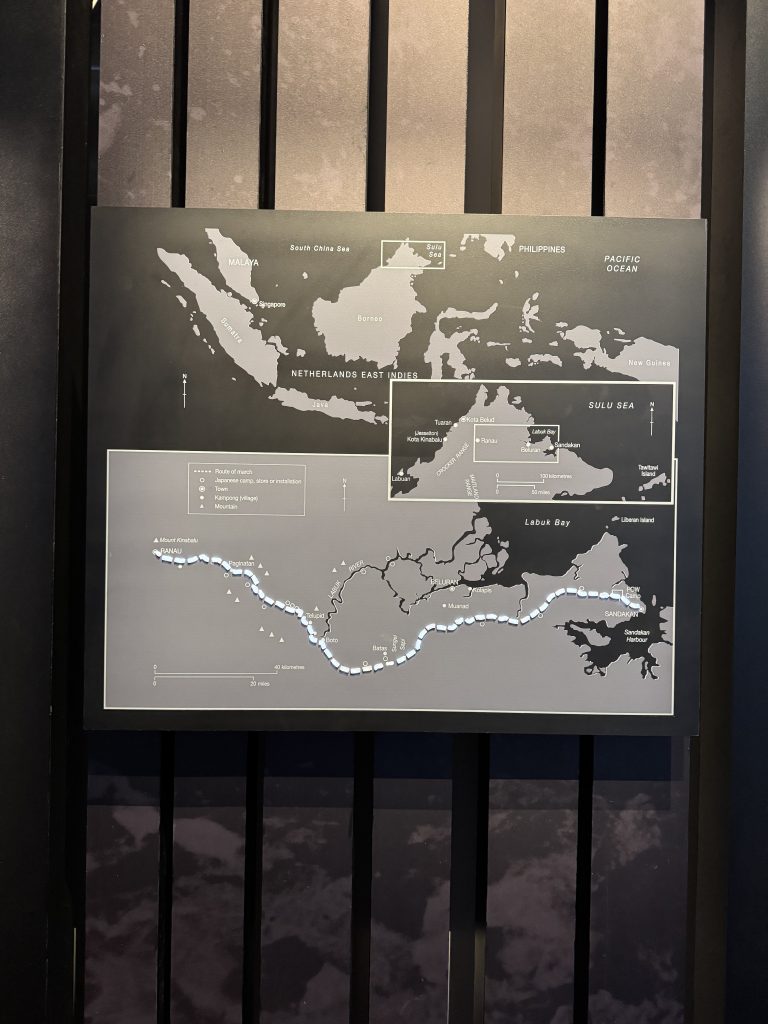
Sarah told me about her grandmother, who hated the Japanese until the day she died. When Borneo was invaded, she and some other girls took to the hills, and lived in the jungle until Borneo was finally liberated. That would have been a very hard few years.
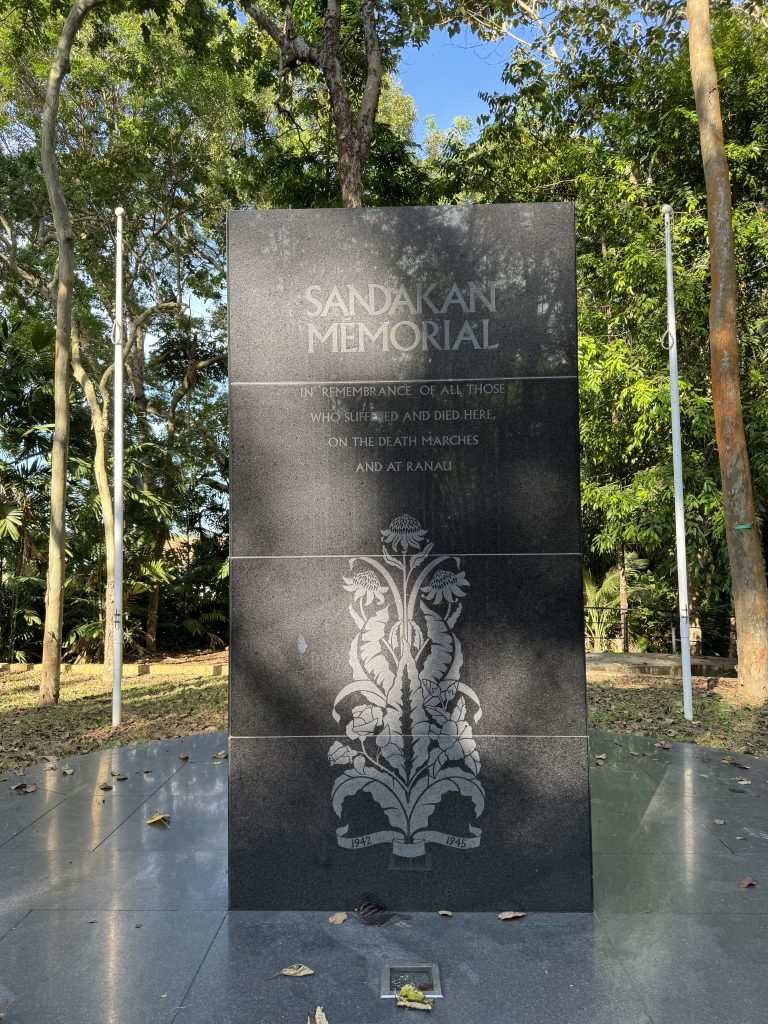
The monument stands where the Big Tree used to stand. This was a lone tree that stood above the Australian camp.
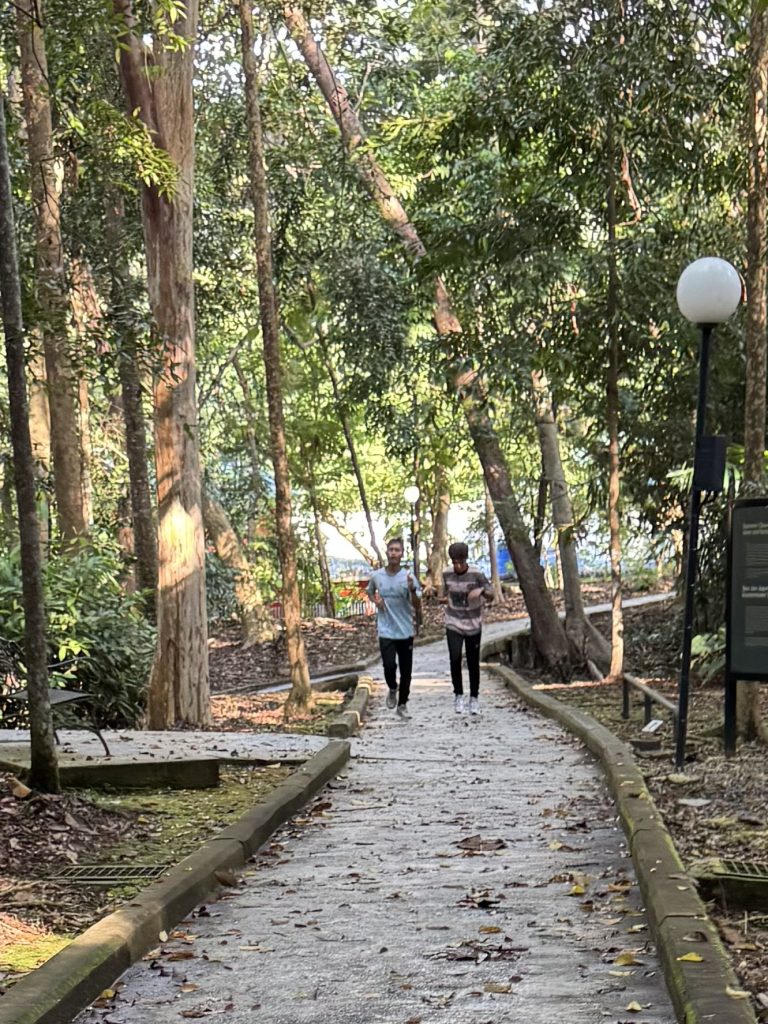
It was so nice to see the locals using the memorial park to enjoy and celebrate life. The wedding party, the mother taking her child out for a walk, and the runners using it as a circuit course.
This place has seen enough death.
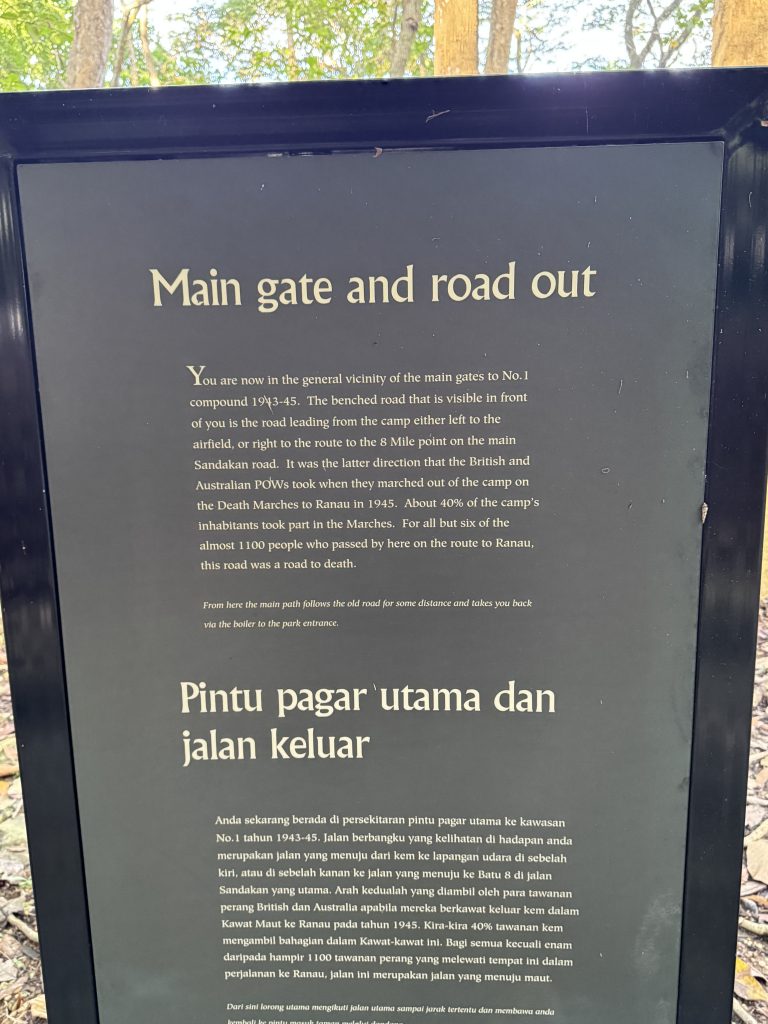
I found this part of the circuit very poignant. Imagine how many times the men would have dreamed of being able to walk down this path, through the gate and never see this place again?
Be careful what you wish for.
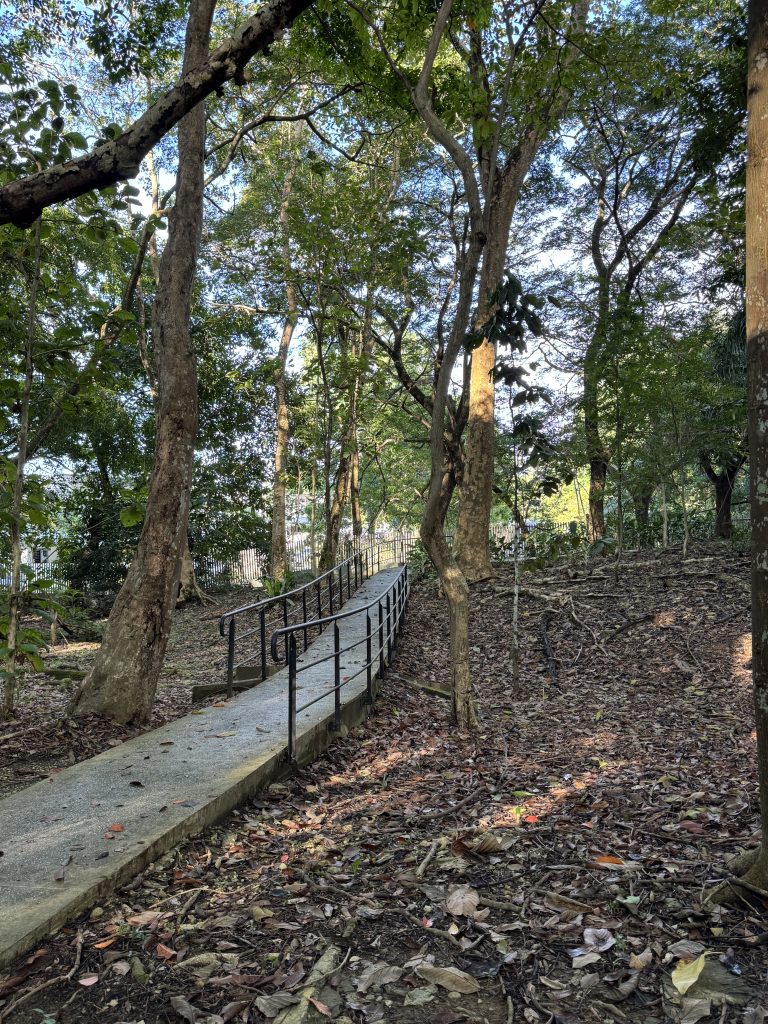
When we got back to the hotel, I looked out of the window, saw rain approaching from the other side of the harbour and decided to grab an early dinner. My dinner companions from last night had the same idea, and they grabbed an extra chair for me to join them.
The rain poured down as we ate. I’m glad this group is on the tour.
Here are some fun facts I forgot to mention yesterday:
Orangutans love figs. In 1993 a woman who was wearing red (like a fig) was grabbed by an orangutan and stripped naked. It thought she was a fig. So we were warned not to wear red, orange and yellow. “But they are pretty much the only colours I’ve brought with me!” said Jenny, one of the women in the group.
Dowry… cigarettes. 20 cigarettes is the usual dowry. Not packets of cigarettes. Just 20 individual ones.
Dad joke of the day:
If anyone has any salad jokes lettuce know.
Thanks I love reading your blog.